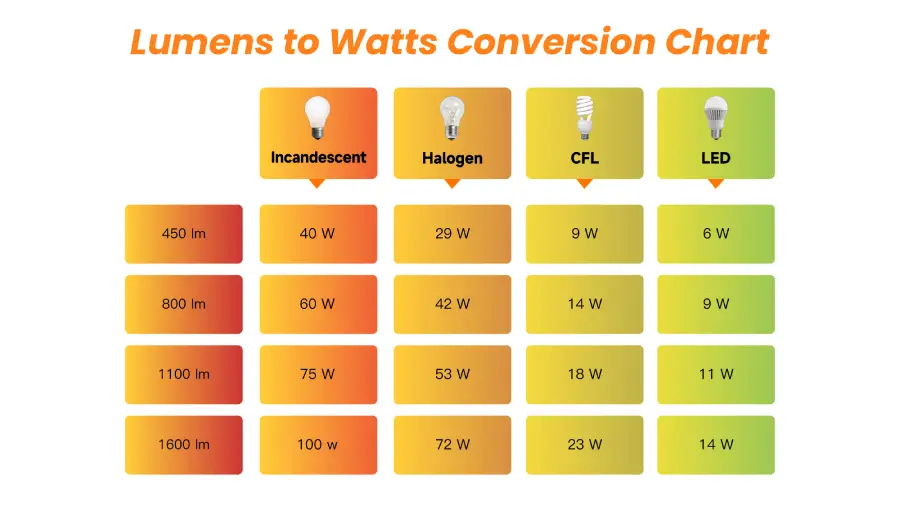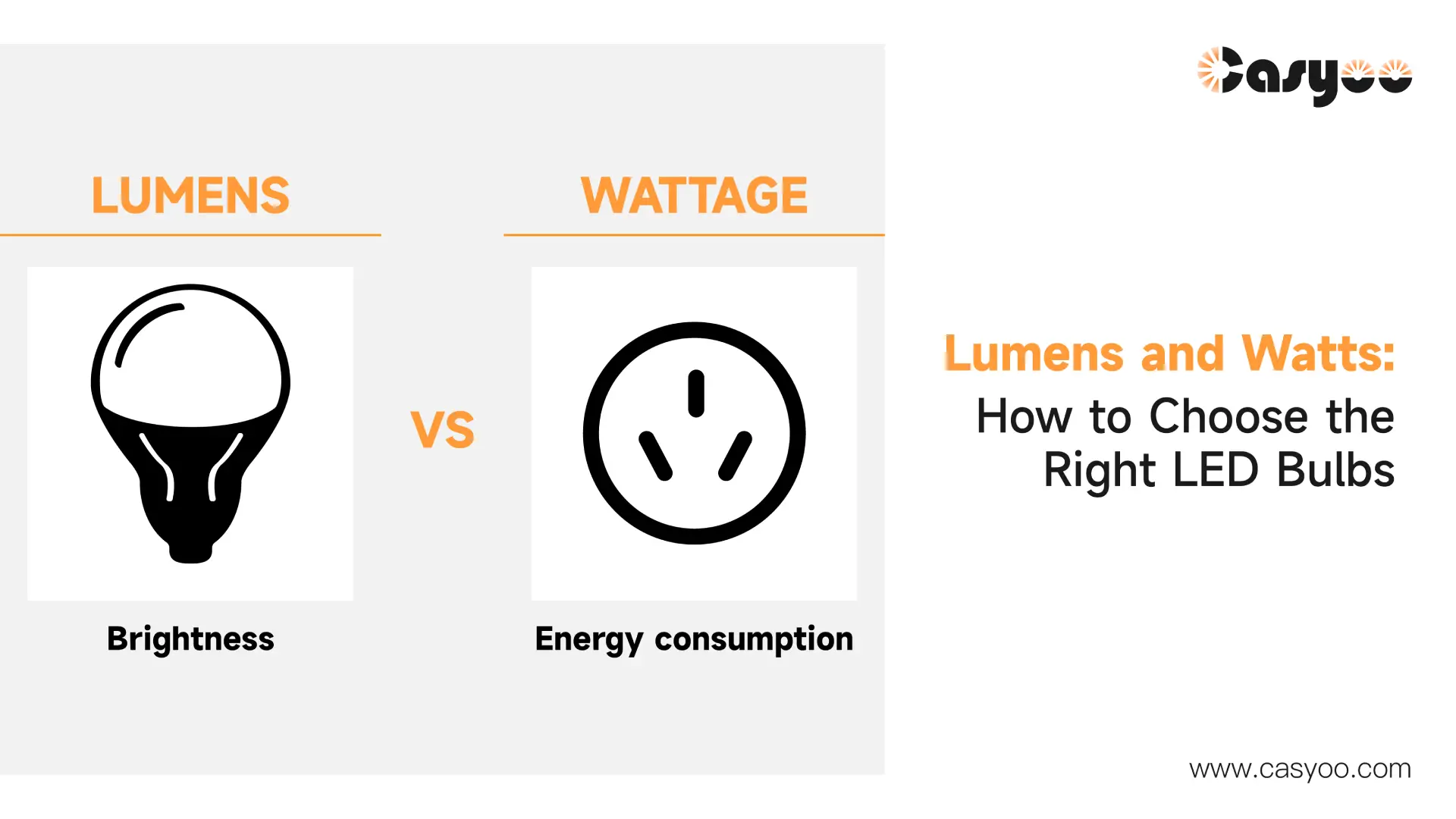The adoption of energy-efficient fluorescent as well as LED lamps has replaced traditional incandescent lamps more frequently during recent years. Unlike the era when incandescent lamps dominated the market, if you only consider wattage when choosing lamps today, you are likely to buy lamps with inappropriate brightness. An accurate way to evaluate lamp brightness exists through examination of its lumen output. You can choose lamps more effectively if you read the following text to grasp the concepts and relationship between lumens and watts!
Relationship between Lumens and Watts
What is Lumen?
Lumen, denoted as lm, is defined in terms of the candela steradian angle (cd*sr). One lumen measures the light source output that has 1 candela intensity in a 1 steradian solid angle. The passing of all light through a designated specific area during a particular time period defines luminous flux. This method disregards light direction patterns and intensity distribution to determine the total quantity of light output from a source. A light source’s brightness depends on lumen measurements; greater lumen values produce more light.
What is Watt?
One important metric for evaluating an equipment’s energy usage is power. In the case of lighting, power directly influences both energy usage and light output. Greater power in lamps of the same type leads to increased brightness while simultaneously raising energy use.
What is Luminous Efficacy?
Light efficacy describes the calculation of a light source luminous flux and power consumption ratio expressed in lumens per watt (lm/W). The lamps demonstrate different capabilities to convert electrical power into illuminated energy. For instance, the majority of the electrical energy in incandescent lamps is wasted as heat, and their luminous efficacy is quite low at fewer than 20 lumens per watt. Technological development has led to a continuous improvement of lamp luminous efficiency. For instance, high-pressure sodium lights attain 80 lm/w which exceeds the performance levels of fluorescent lamps at 50 lm/w. Today, the most popular LED lamps boast luminous efficiencies of 120 lumens per watt or even higher.
Lumen to Watt Comparison: Which One Indicates Brightness?
In 2011, the U.S. Federal Trade Commission mandated that manufacturers use lumens to indicate the brightness of their products. Given the vast array of lights currently on the market, there might be a substantial difference in the efficiency of various light sources or brands. The same wattage rating can correspond to multiple brightness levels in various light bulbs. For example, the lumen output of a 9W LED bulb, a 15W compact fluorescent light, and a 60W incandescent bulb is the same. Using wattage alone to select bulbs no longer serves as a dependable method for choosing bulbs. People need to understand the importance of checking “lumens” information instead.
How to Convert Lumens to Watts?
Luminous efficacy establishes the electrical power-wattage relationship through which we calculate the conversion between lumens and watts. The calculation formula is:
Watt = Lumen / Luminous Efficacy
For instance, if 800 lumens of brightness is required and an LED lamp with a luminous efficacy of 80 lm/W is chosen, the required power can be calculated as follows:
W = 800 Lm / 80 Lm/W = 10 W
As LED lamps offer the highest efficiency, they consume the least power to produce the same brightness. The table demonstrates a comparison of various light sources according to their power and lumen levels.

The Lumen to Watt Calculator on Casyoo provides a quick and straightforward solution to determine power and lumens requirements. Access the Lumen to Watt Calculator through Casyoo. You may quickly choose the alternatives that best fit your needs because we’ve provided a variety of application scenarios and light types. A single click will display the ideal wattage and related lumen output for your lamp.
Lumens and Watts: Choosing the Right Bulb for Your Needs
Public opinion dictates the purchase of high-power bulbs because they believe better lighting is achieved through brightness alone. However, different areas with their separate illumination needs demand customized lighting systems. People need to consider the following vital factors before selecting their lamp.
Room Size
First, we need to understand illumination’s definition as the brightness per unit area. It is calculated as lumens divided by the area. Understanding illumination helps in setting appropriate lighting standards. Various lighting associations or regional lighting guidelines use illuminance as the standard for brightness. Spaces of the same type generally share the same illumination requirements, so you can simply multiply the standard illumination level by the site area to determine the required total lumens. Naturally, the larger the area, the higher the total lumens needed, as more lights will be necessary to achieve the desired brightness.
Usage
The table below lists the lighting specifications for typical lighting situations. Choosing lamps according to their illuminance guarantees that the brightness is suitable for the particular tasks taking place in each area.
| Space | Lux level (lx) |
| Bedroom | 150 |
| Living room | 200 |
| Dining room | 150 |
| Kitchen | 250 |
| Bathroom | 150 |
| Balcony | 150 |
| Streets | 20-30 |
| Parking lot | 20-50 |
| Garden | 15-20 |
| Offices | 400-500 |
| Retail stores | 400-500 |
Here’s an example for you to know how many lumens you need for a certain space:
What lumens should I consider for a 10 m² bedroom space?
Lumen= Lux level* Area=150*10=1500 lumens
If you plan to buy a 100 lm/w LED lamp, the wattage you need is:
Watt= Lumen/ Luminous efficacy= 1500/100=15 watt
Desired Lighting Effect
Each person possesses distinct preferences regarding illumination types. People choose between gentle or intense lighting according to their preferences. After understanding the illumination standards for different settings and determining the required lumen range for your space, you can choose lights with slightly higher lumens if you prefer a brighter ambiance, and vise versa.
The Longevity and Cost-Effectiveness of LED
LED lights deliver maximum efficiency which makes them excellent for those who need to reduce their electricity bills. This implies that LED lights use a lot less power to produce the same amount of brightness, which lowers the amount of electricity used. Other main advantages of LED lighting include numerous application possibilities alongside extended operational duration.
Color Temperature and CRI
When selecting lighting you should understand the brightness relationship between lumens and watts to match your environment correctly. However, other lamp characteristics are equally important. For instance, the establishment of mood depends greatly on choosing the correct color temperature in design environments. A lower color temperature can make the light appear softer and may visually reduce its brightness. The Color Rendering Index (CRI) determines the accuracy of color display under a light source. A higher CRI is one of the standout features of LED lamps, ensuring better clarity in the illuminated space.
Lumens and Watts: Frequently Asked Questions
- How Many Lumens Is a 100/60/50/40 Watt Bulb?
| Watt (W) | Lumens (lm) | |
| LED | Incandescent | |
| 100 | 10000 | 1500 |
| 60 | 6000 | 900 |
| 50 | 5000 | 750 |
| 40 | 4000 | 600 |
- How Bright Is 2000/5000/10,000 Lumens?
- 2000 lumens: 6-7 m² living Rooms; 200 m² outdoor paths
- 5000lumens: 12-15 m² kitchens; 6-7 m² retail stores
- 10,000 lumens: 10 m² stadiums; 200 m² yard (security lighting)
- What Is the Difference Between Lumens and Lux?
Lux= lumen/ area. The illumination standard for the particular place must be taken into account in order to determine the exact lumen value.
- What Is LED Bulbs Equivalent Wattage to 40 Watts?
The 40 watts mentioned here typically refers to incandescent lamps. To help customers choose LED lamps more easily, LED products are often labeled as “40 watts equivalent.” This indicates that the LED lamp provides a similar level of brightness, but its actual power consumption is only around 6 watts.
- How Far Can You See With 2200 Lumens?
To know how far the light can be cast, you need to consider the optical design of specialty lamps, such flashlights or automotive headlights, especially if they have a wide or narrow beam. A large beam usually illuminates an area of around 50 meters, but a narrow beam can illuminate up to 200 meters.
Stop guessing bulb brightness! Casyoo’s Lumen Calculator gives instant answers! The objective is to combine lumens and watts for maximizing efficiency rather than selecting one measurement method over another. You can prevent excessive lighting expenses by adopting Casyoo tools combined with the advice in this passage.
Related reading:




